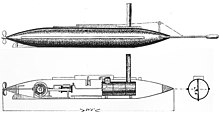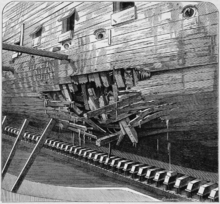Spar torpedo
This article needs additional citations for verification. (June 2007) |



A spar torpedo is a weapon consisting of a bomb placed at the end of a long pole, or spar, and attached to a boat. The weapon is used by running the end of the spar into the enemy ship. Spar torpedoes were often equipped with a barbed spear at the end, so it would stick to wooden hulls. A fuse could then be used to detonate it.
Invention
[edit]Robert Fulton had written about submarine (i.e., subsurface) marine torpedoes in 1810,[1] and experiments were conducted using spar torpedoes that year.[2] Boats carrying spar torpedoes were used during the War of 1812.[3]
E. C. Singer, a private engineer who worked on secret projects for the benefit of the Confederate States of America, constructed a spar torpedo during the American Civil War. His torpedo was detonated by means of a trigger mechanism adapted from a rifle lock (see flintlock mechanism for a similar device). The spring-loaded trigger[4] was detonated by means of a long cord attached to the attacking vessel. The attacking vessel rammed its target, embedding the barbed torpedo in its hull, then backed off. When the attacker reached the limit of the trigger cord, the torpedo was detonated.
Use
[edit]
Perhaps the most famous use of spar torpedoes during the U.S. Civil War was by the Confederate submarine H. L. Hunley, which managed to sink the Union screw sloop USS Housatonic on February 17, 1864, although the Hunley was lost. Spar torpedoes were also used by the David-class of semi-submersible attack boats. In April 1864, Confederate torpedo boat CSS Squib employed a spar torpedo against USS Minnesota.[5][6]
At night on October 27–28, 1864, Lieutenant Cushing employed a spar torpedo to sink the Confederate ironclad ram CSS Albemarle. The sinking of the Albemarle was the Union navy's only successful sinking of a Confederate vessel by torpedo. Lieutenant Cushing employed a spar torpedo designed by John Lay.
The semi-submersible 1864 Union craft USS Spuyten Duyvil employed a spar torpedo, but not with a barbed attachment to the target. Owing to an innovative directable and extensible spar, this craft could release a slightly buoyant mine underneath the target, which would be exploded by the means described above. (This craft was not employed against Confederate targets, but was used to clear wreckage from rivers.)
Spar torpedoes were also used on small wooden launches in the late 19th century, although they were not very useful weapons. The locomotive torpedo (the contemporary term for the modern self-propelled torpedo) replaced the spar torpedo as a weapon for submarines and small boats in the 1870s.

Spar torpedoes were also used by Romanian forces during the country's war of independence. On May 26, 1877, the craft Rândunica sank the Ottoman river monitor Seyfi on the Danube.[7]
French admiral Courbet made good use of two spar torpedo boats at the Battle of Fuzhou on August 23, 1884, which sank the flagship of the Chinese Fujian Fleet - corvette Yangwu and a gunboat Fuxing. It showed that spar torpedoes can be effective against ships at anchor, not protected by torpedo nets and without a proper look-out.[8] On February 14, 1885, Courbet also sank Chinese frigate Yuyuan in Battle of Shipu with two spar torpedo boats.
Spar torpedoes were superseded by the automotive torpedo.
See also
[edit]Sources
[edit]- ^ Fulton, Robert, Torpedo War, and Submarine Explosions. William Elliot (1810)
- ^ Experiments on the practical use of the torpedo, communicated to the House of Representatives, February 14, 1811. 11th Congress, 3d session, illus. (In: American State Papers, Washington, 1834, v. 14, Naval affairs, v. 1, pp. 234-244.
- ^ Branfill-Cook, Roger, Torpedo: The Complete History of the World's Most Revolutionary Naval Weapon, p. 18. Seaforth Publishing (2014).
- ^ "The Battle of Mobile Bay: "Damn the Torpedoes!"". Historical Marker Database. Retrieved 25 September 2015.
- ^ CSS Squib. Naval History and Heritage Command.
- ^ St. John Erickson, Mark, "A daring Confederate night attack on the Union fleet off Newport News Point", Daily Press, April 4, 2014.
- ^ Cristian Crăciunoiu, Romanian Navy Torpedo Boats, p. 19
- ^ Brassey's Annual; the Armed Forces Year-book, Praeger Publishers, 1888, p. 489
